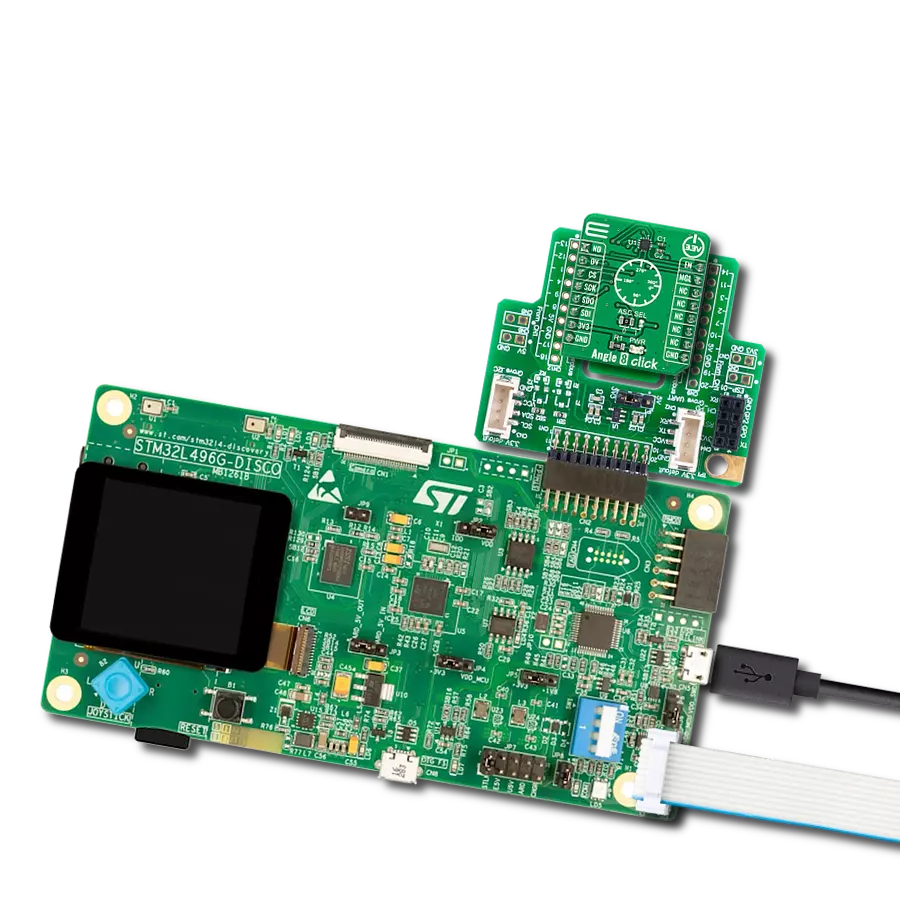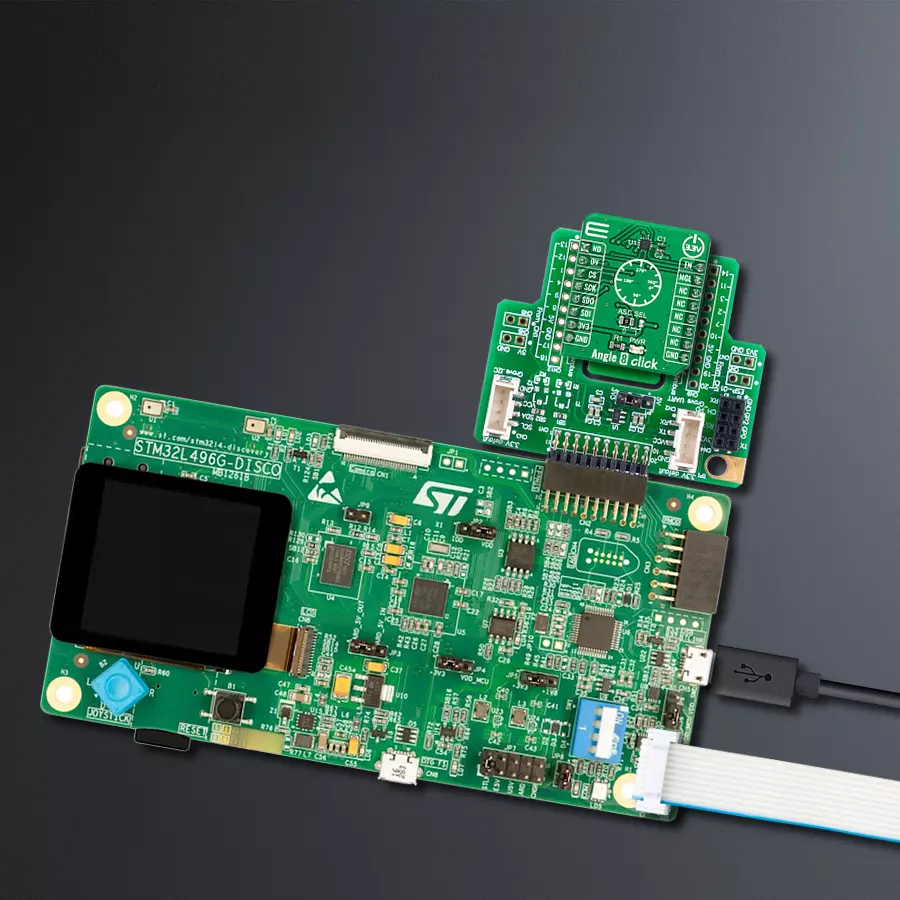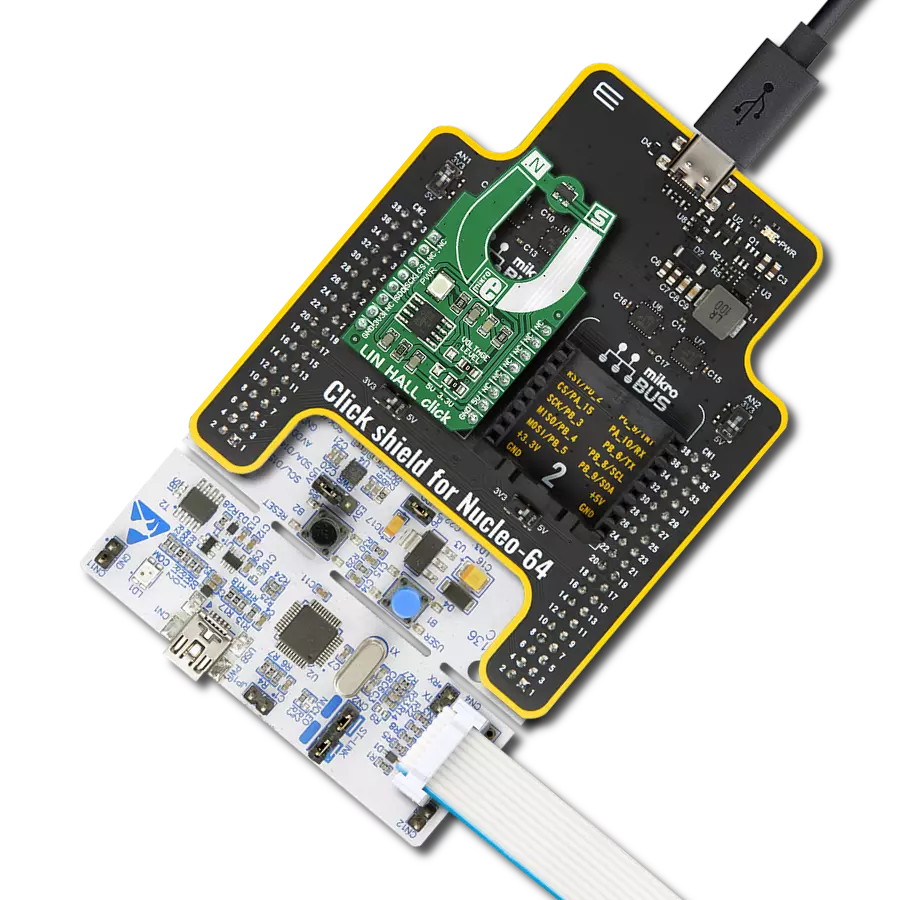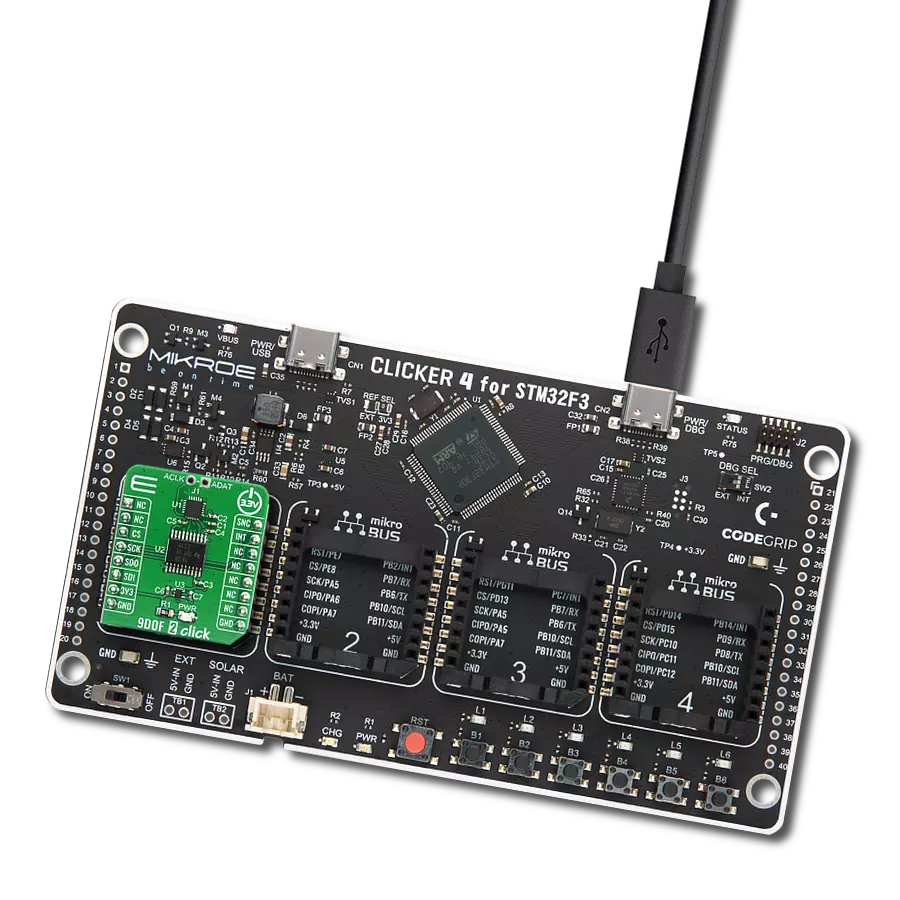Experience a new level of precision with our magnet angular position solution, designed to provide real-time data on the absolute orientation of permanent magnets
A
A
Hardware Overview
How does it work?
Angle 8 Click is based on the MA782GGU, a low-power angle sensor with integrated wake-up angle detection from Monolithic Power Systems. It allows users to read angle position information and detect the speed or direction of magnet rotation. With its power cycling ability, the MA782GGU can be optimized for applications that require low average power. Fast data acquisition and processing provide accurate angle measurement at an applied magnetic field of 60mT. It supports many magnetic field strengths and spatial configurations, with both end-of-shaft and off-axis (side-shaft mounting) supported configurations. The MA782GGU features magnetic field strength detection with configurable thresholds to sense the magnet position relative to the sensor for certain functions (e.g., sensing the axial movements or diagnostics). On-chip non-volatile memory stores configuration parameters,
including the reference zero angle position, the power cycling parameters, the filter window affecting the output resolution, and magnetic field detection thresholds. The Angle 8 Click communicates with MCU using the standard SPI serial interface for angle reading and register programming, which supports SPI Mode 0 and 3 and operates at clock rates up to 25 MHz. This Click board™ uses the Enable pin labeled as EN and routed to the CS pin of the mikroBUS™ socket to optimize power consumption, used for its power ON/OFF purposes. It has three power modes: Active, Idle, and Automatic sampling cycle (ASC). Combining these three power modes, the MA782GGU can be operated differently. In ASC mode, the MA782GGU switches between Active and Idle mode. The selection can be made by positioning the SMD jumper labeled ASC SEL to an appropriate position marked as 0 or 1. Besides
these pins, it also uses two indicators, new data and data valid indicators labeled as ND and DV routed to the AN and RST pins of the mikroBUS™ socket. In ASC mode, the ND signal indicates when new data is ready to be read or if the displacement exceeds the defined threshold, while the DV signal indicates the stabilization of the digital filter. It also has the magnetic flag used to indicate when the sensor position's magnetic field is out of range, defined by the lower magnetic field thresholds, routed on the INT pin of the mikroBUS™ socket labeled as MGL. This Click board™ can be operated only with a 3.3V logic voltage level. The board must perform appropriate logic voltage level conversion before using MCUs with different logic levels. Also, it comes equipped with a library containing functions and an example code that can be used as a reference for further development.
Features overview
Development board
The 32L496GDISCOVERY Discovery kit serves as a comprehensive demonstration and development platform for the STM32L496AG microcontroller, featuring an Arm® Cortex®-M4 core. Designed for applications that demand a balance of high performance, advanced graphics, and ultra-low power consumption, this kit enables seamless prototyping for a wide range of embedded solutions. With its innovative energy-efficient
architecture, the STM32L496AG integrates extended RAM and the Chrom-ART Accelerator, enhancing graphics performance while maintaining low power consumption. This makes the kit particularly well-suited for applications involving audio processing, graphical user interfaces, and real-time data acquisition, where energy efficiency is a key requirement. For ease of development, the board includes an onboard ST-LINK/V2-1
debugger/programmer, providing a seamless out-of-the-box experience for loading, debugging, and testing applications without requiring additional hardware. The combination of low power features, enhanced memory capabilities, and built-in debugging tools makes the 32L496GDISCOVERY kit an ideal choice for prototyping advanced embedded systems with state-of-the-art energy efficiency.
Microcontroller Overview
MCU Card / MCU

Architecture
ARM Cortex-M4
MCU Memory (KB)
1024
Silicon Vendor
STMicroelectronics
Pin count
169
RAM (Bytes)
327680
Used MCU Pins
mikroBUS™ mapper
Take a closer look
Click board™ Schematic

Step by step
Project assembly
Track your results in real time
Application Output
1. Application Output - In Debug mode, the 'Application Output' window enables real-time data monitoring, offering direct insight into execution results. Ensure proper data display by configuring the environment correctly using the provided tutorial.

2. UART Terminal - Use the UART Terminal to monitor data transmission via a USB to UART converter, allowing direct communication between the Click board™ and your development system. Configure the baud rate and other serial settings according to your project's requirements to ensure proper functionality. For step-by-step setup instructions, refer to the provided tutorial.

3. Plot Output - The Plot feature offers a powerful way to visualize real-time sensor data, enabling trend analysis, debugging, and comparison of multiple data points. To set it up correctly, follow the provided tutorial, which includes a step-by-step example of using the Plot feature to display Click board™ readings. To use the Plot feature in your code, use the function: plot(*insert_graph_name*, variable_name);. This is a general format, and it is up to the user to replace 'insert_graph_name' with the actual graph name and 'variable_name' with the parameter to be displayed.

Software Support
Library Description
This library contains API for Angle 8 Click driver.
Key functions:
angle8_get_nd_pin- This function returns the new data ready (ND) pin logic stateangle8_set_cycle_time- This function sets the sensor cycle time (measurement rate) in millisecondsangle8_read_angle- This function reads raw angle data and converts it to degrees
Open Source
Code example
The complete application code and a ready-to-use project are available through the NECTO Studio Package Manager for direct installation in the NECTO Studio. The application code can also be found on the MIKROE GitHub account.
/*!
* @file main.c
* @brief Angle8 Click example
*
* # Description
* This example demonstrates the use of Angle 8 Click board by reading and displaying
* the magnet's angular position in degrees.
*
* The demo application is composed of two sections :
*
* ## Application Init
* Initializes the driver and performs the Click default configuration which
* sets the clockwise rotation direction and cycle time to 100ms.
*
* ## Application Task
* Waits for the new data ready flag and then reads the magnet's angular position in degrees
* and displays the results on the USB UART.
*
* @author Stefan Filipovic
*
*/
#include "board.h"
#include "log.h"
#include "angle8.h"
static angle8_t angle8;
static log_t logger;
void application_init ( void )
{
log_cfg_t log_cfg; /**< Logger config object. */
angle8_cfg_t angle8_cfg; /**< Click config object. */
/**
* Logger initialization.
* Default baud rate: 115200
* Default log level: LOG_LEVEL_DEBUG
* @note If USB_UART_RX and USB_UART_TX
* are defined as HAL_PIN_NC, you will
* need to define them manually for log to work.
* See @b LOG_MAP_USB_UART macro definition for detailed explanation.
*/
LOG_MAP_USB_UART( log_cfg );
log_init( &logger, &log_cfg );
log_info( &logger, " Application Init " );
// Click initialization.
angle8_cfg_setup( &angle8_cfg );
ANGLE8_MAP_MIKROBUS( angle8_cfg, MIKROBUS_1 );
if ( SPI_MASTER_ERROR == angle8_init( &angle8, &angle8_cfg ) )
{
log_error( &logger, " Communication init." );
for ( ; ; );
}
if ( ANGLE8_ERROR == angle8_default_cfg ( &angle8 ) )
{
log_error( &logger, " Default configuration." );
for ( ; ; );
}
log_info( &logger, " Application Task " );
}
void application_task ( void )
{
if ( angle8_get_nd_pin ( &angle8 ) )
{
float angle = 0;
if ( ANGLE8_OK == angle8_read_angle ( &angle8, &angle ) )
{
log_printf ( &logger, " Angle: %.2f Deg \r\n\n", angle );
}
}
}
int main ( void )
{
/* Do not remove this line or clock might not be set correctly. */
#ifdef PREINIT_SUPPORTED
preinit();
#endif
application_init( );
for ( ; ; )
{
application_task( );
}
return 0;
}
// ------------------------------------------------------------------------ END
Additional Support
Resources
Category:Magnetic































